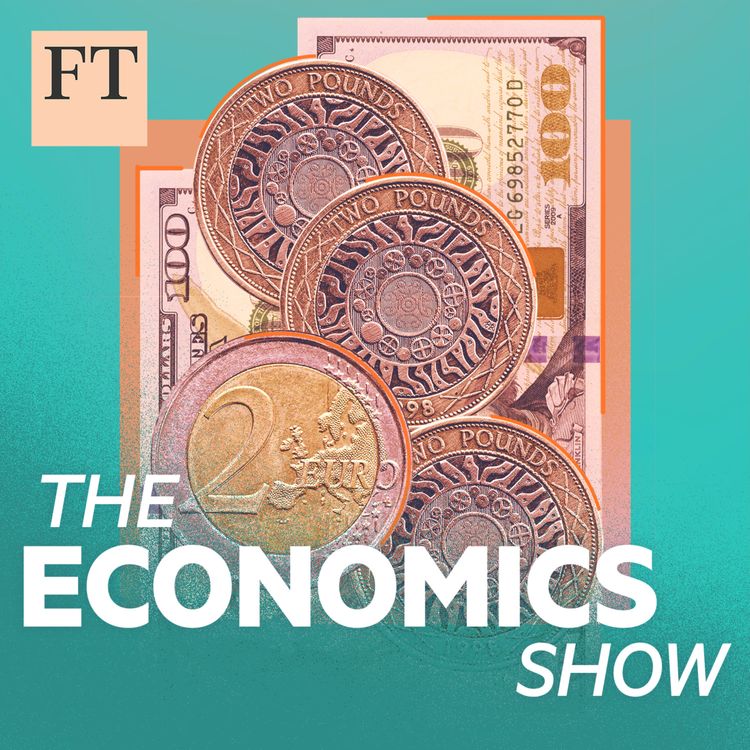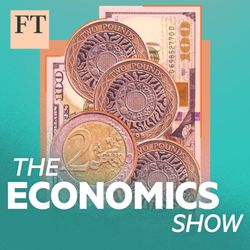Share

The Economics Show
What would Trump do on trade? With Alan Beattie
•
This campaign, candidate Donald Trump is promising even more extreme versions of the policies that marked his first term. But what would higher, and more widespread, tariffs actually look like? And in what form would any retaliation come? Today on the show, Soumaya and the FT’s senior trade writer Alan Beattie discuss the candidate’s campaign promises on trade, and where they might lead.
Soumaya Keynes writes a column each week for the Financial Times. You can find it here
Subscribe to Soumaya's show on Apple, Spotify, Pocket Casts or wherever you listen.
More episodes
View all episodes

Martin Wolf speaks to Christine Lagarde: Europe’s ‘existential crisis’
25:02|The European Commission must urgently dismantle internal trade barriers that are stifling innovation, productivity and investment across the EU. So says Christine Lagarde, president of the European Central Bank, in a conversation with the FT’s chief economics commentator, Martin Wolf, as she calls for immediate structural reforms and explains why this is the moment to do it.This interview was recorded on December 10 as part of the FT’s The Global Boardroom conference.Subscribe and listen to this series of The Economics Show on Apple Podcasts, Spotify, Pocket Casts or wherever you listen to podcasts. Read Martin’s column here Sound design and original music by Breen Turner.Read a transcript of this episode on FT.com
The Wolf-Krugman Exchange: Power, plutocracy and political economy
42:35|In this final episode of their series for The Economics Show, FT chief economics commentator Martin Wolf and Nobel laureate Paul Krugman consider listeners’ questions and comments ranging from a critique of globalisation, increasing inequality and plutocracy, the global appetite for US federal debt, China’s economic future and much more.Subscribe and listen to this series of The Economics Show on Apple Podcasts, Spotify, Pocket Casts or wherever you listen to podcasts. Read Martin’s column here Subscribe to Paul’s substack hereFind Paul’s cultural coda here.Find Martin’s cultural coda here.Produced by Mischa Frankl-Duval and Josh Gabert-Doyon. Manuela Saragosa is the executive producer. Tom Hannen is the video editor. Sound design and original music by Breen Turner.Read a transcript of this episode on FT.com
The Wolf-Krugman Exchange: America vs the world
41:57|The US last week released its new national security strategy – and it wasn’t good news for Europe. The document, which sets out US foreign policy priorities, blasted Europe for undermining “political liberty and sovereignty”, de-emphasised the threat from Russia, reframed America’s competition with China and put influence over the western hemisphere at the top of the US agenda. In this episode, FT chief economics commentator Martin Wolf and Nobel laureate Paul Krugman discuss what the impact of this new US strategy may be. How should Europe react to this sharp turn from its strongest historical ally? And is Trump handing China the world on a silver platter?Email any questions for Martin and Paul to economics.show@ft.comSubscribe and listen to this series of The Economics Show on Apple Podcasts, Spotify, Pocket Casts or wherever you listen to podcasts. Read Martin’s column here Subscribe to Paul’s Substack hereFind Paul’s cultural coda here.Find Martin’s cultural coda here.Produced by Mischa Frankl-Duval. Manuela Saragosa is the executive producer. Tom Hannen is the video editor. Sound design by Breen Turner. Original music by Breen Turner.The Wolf-Krugman Exchange: America vs the world videoRead a transcript of this episode on FT.com
The Wolf-Krugman Exchange: Maga man and Mamdani
37:30|Donald Trump promised to bring industrial jobs back to America when he swept to victory in last year’s presidential election, powered by a 12-point lead among male voters, but can he really deliver? In the second of this four-part series, the FT’s chief economics commentator Martin Wolf and Nobel prize-winning economist Paul Krugman discuss the economic plight of American men - why their problems are real, but Maga’s proposed solutions are not. Plus, they consider the policy platform of another populist, the newly elected mayor of New York City, Zohran Mamdani, and whether his affordability agenda can translate into a nationwide policy for the Democrats.Subscribe and listen to this series of The Economics Show on Apple Podcasts, Spotify, Pocket Casts or wherever you listen to podcasts. Read Martin’s column here Subscribe to Paul’s substack hereFind Paul’s cultural coda hereFind Martin’s cultural coda hereProduced by Mischa Frankl-Duval. Manuela Saragosa is the executive producer. Sound design by Sam Giovinco and Breen Turner. Original music by Breen Turner.Read a transcript of this episode on FT.com
The Wolf-Krugman Exchange: Trump’s ‘vibecession’
40:31|As President Donald Trump approaches the one-year anniversary of his second term in office, the FT’s chief economics commentator Martin Wolf, and Nobel prize-winning economist Paul Krugman sit down to discuss the US economy and the state of American democracy. Are American consumers finally feeling the effect of Trump’s tariffs? Is AI to blame for the frozen labour market? Or is the spectre of a weakening democracy and plutocracy to blame for slumping consumer sentiment? In the first of four weekly episodes, Wolf and Krugman unpick the US and world economy, with Krugman explaining why he’s less pessimistic now than he was earlier this year.Subscribe and listen to this series of The Economics Show on Apple Podcasts, Spotify, Pocket Casts or wherever you listen to podcasts. Read Martin’s column here.Subscribe to Paul’s Substack here.Find Paul’s cultural coda here.Find Martin’s cultural coda here.Produced by Mischa Frankl-Duval. Manuela Saragosa is the executive producer. Original music and sound design by Breen Turner.Read a transcript of this episode on FT.com
Coming soon: The Wolf-Krugman Exchange: One year of Trump
01:50|In this four-part series starting on Wednesday November 26, FT chief economics commentator Martin Wolf and Nobel-prize winning economist Paul Krugman take stock after (almost) a year of Donald Trump’s second term and assess the impact of his presidency on the US and world economy and democracy everywhere.Martin Wolf is the FT’s chief economics commentator. You can find his articles here: https://www.ft.com/martin-wolfYou can find Paul Krugman’s Substack newsletter here Subscribe to The Economics Show on Apple, Spotify, Pocket Casts or wherever you listen.Presented by Martin Wolf. Produced by Mischa Frankl-Duval. The executive producer is Manuela Saragosa. Original music and sound design by Breen Turner.
Did globalisation kill neoliberalism? With Branko Milanović
32:37|Thirty-five years ago, the global economy could be neatly divided into market economies, socialist economies and poorer non-aligned countries. Today, that picture is rather more complicated. Western-style neoliberalism – expected to become the dominant economic system after the end of the cold war – is in retreat; socialism is no more; China has emerged as a global superpower; and formerly-poor countries in the global south are rising rapidly – all while neoliberalism itself becomes, well… less liberal. If neoliberalism is on the way out, what will replace it? And what does the rise of Asia mean for western consumers who find their spending power dwindling? The FT’s European economics commentator, Martin Sandbu, speaks to Branko Milanović, senior scholar at the Stone Center on Socio-Economic Inequality at the City University of New York, and a visiting professor at the International Inequalities Institute at the LSE.Further ReadingGlobalisation: Where on the elephant are you? (BBC)Branko Milanovic: ‘The forces of self-interest and technology cannot be undone’The economic losers are in revolt against the elites Martin Sandbu is the Financial Times's European economics commentator. You can find his articles here: https://www.ft.com/martin-sandbuSubscribe to The Economics Show on Apple, Spotify, Pocket Casts or wherever you listen. To sign up for free to the new FT Alphaville newsletter on substack, go to ftav.substack.comPresented by Martin Sandbu. Produced by Mischa Frankl-Duval and Lulu Smyth. Manuela Saragosa is the executive producer. Original music and sound design by Breen Turner.Read a transcript of this episode on FT.com
Coming soon from Tech Tonic: Defying death
01:30|Investors are spending billions of dollars on novel ways to extend human life through inventive treatments, therapies, and even manipulating our genes. And increasingly, it seems as though anti-ageing efforts have moved from the super rich to a mass market consumer industry. In this series, we’re covering the past, present and future of the longevity movement. We’ll be looking at where the fixation on longevity is coming from, and trying to understand the practical and ethical issues at the heart of this cutting-edge field of research. From Silicon Valley fantasies, to Singaporean health spas, to Colombian genetic clinics and beyond, the FT’s Hannah Kuchler and Michael Peel ask whether breakthroughs in science and technology can really help us live longer, and even stop us aging altogether.Free to read: US ‘wellness’ industry scents opportunity to go mainstreamThe quest to make young blood into a drugThis season of Tech Tonic was produced by Josh Gabert-Doyon. The senior producer is Edwin Lane. Flo Phillips is the executive producer. Sound design by Breen Turner and Samantha Giovinco. Fact checking by Simon Greaves, Lucy Baldwin and Tara Cromie. Original music by Metaphor Music. Manuela Saragosa is the FT’s acting co-head of audio.The FT does not use generative AI to voice its podcasts.
The limits of monetary policy, with Agustín Carstens
30:54|Money, it’s often said, is a form of trust and central banks are the custodians of that trust; it’s their job to guarantee that the money they issue maintains stable purchasing power. More recently, that’s been no easy task. Witness President Donald Trump’s attacks on the independence of the US Federal Reserve. The FT’s chief economics commentator, Martin Wolf, speaks to Agustín Carstens, former general manager of the Bank for International Settlements – the “central bank of central banks” – and one-time governor of the Bank of Mexico, to discuss what central banks can do to maintain trust in a fractured world and asks if they must modernise to maintain authority.Martin Wolf is the FT’s chief economics commentator. You can read his columns here: https://www.ft.com/martin-wolfSubscribe to The Economics Show on Apple, Spotify, Pocket Casts or wherever you listen. Presented by Martin Wolf. Produced by Mischa Frankl-Duval. Manuela Saragosa is the executive producer. Original music from Breen Turner, and sound design by Simon Panayi.Register for a November 28 live webinar on what the UK Budget will mean for your money and put your questions to FT journalists Claer Barrett, Stuart Kirk, Tej Parikh and special guest, tax expert Dan Neidle. Get your free pass now at ft.com/budgetwebinarThe webinar will also be broadcast as a bonus edition on two FT podcasts: Claer's Money Clinic and the weekly UK politics show Political Fix, presented by George Parker while Lucy Fisher is on maternity leave.Read a transcript of this episode on FT.com